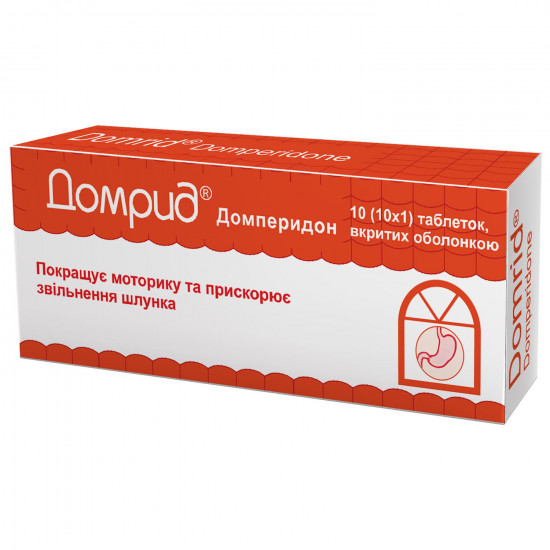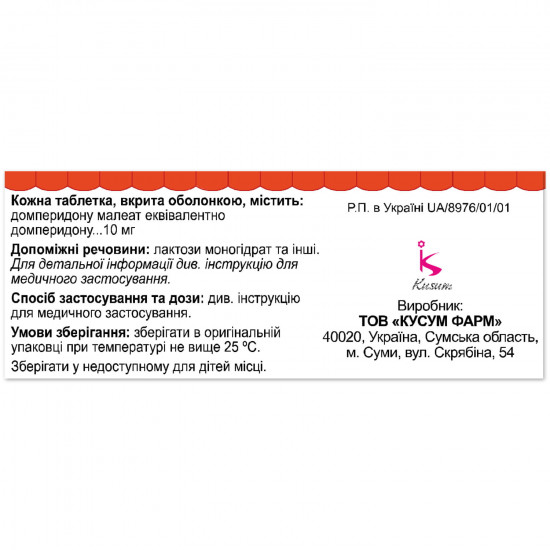





- Stock: In Stock
- Model: 179424
0% Customers recommend this product
-
5 Awesome0%
-
4 Great0%
-
3 Average0%
-
2 Bad0%
-
1 Poor0%
Reviews Over Domrid of the tab. of p/o of 10 mg No. 10
- (0)
Total Reviews (0)
click here write review to add review for this product.
Report this review.
Description
Structure and form of release
Structure
active ingredient: domperidone maleate;
1 tablet supports a domperidon of a maleate is equivalent to a domperidon of 10 mg;
microcrystalline cellulose, croscarmellose sodium, silicon dioxide colloidal waterless, magnesium stearate, a covering of Opadry II 31 G 58920 white which contains lactose, monohydrate; titan dioxide (E171).
release Form
Tablet, coated.
Pharmacological properties
Domperidon – the antagonist of dopamine which has antiemetic properties. Practically does not get through a blood-brain barrier therefore application of a domperidon seldom is followed by extrapyramidal side effects, especially at adults, but domperidon stimulates prolactin discharge from a hypophysis. Antiemetic action is caused by connection of peripheral (gastrokinetichesky) action and antagonism to dopamine receptors in a trigger zone of chemoceptors which is out of a blood-brain barrier.
At intake domperidon is increased by duration of antral and duodenal reductions, accelerates a passage on a stomach – an exit of liquid and semisolid fractions at healthy people and firm fractions at patients at whom this process was slowed down, and increases pressure of a sphincter of a lower part of a gullet at healthy people. Domperidon does not influence gastric secretion.
Domperidon is quickly absorbed byat oral administration on an empty stomach with achievement of the maximum levels in blood plasma in 30–60 min. Bioavailability of a domperidon at intake low (about 15%) due to intensive metabolism in a wall of intestines and in a liver. Though at healthy people the biological availability of a domperidon increases at reception after a meal, patients with disorders of digestive tract need to accept domperidon in 15–30 min. prior to food, at patients with reduced acidity of a stomach the absorption of a domperidon decreases.
Biological availability at oral administration of medicine decreases after the previous intake of Cimetidinum or sodium of bicarbonate. Domperidon is metabolized in a liver by hydroxylation and N-dealkylation. At researches of metabolism of the medicine in vitro using diagnostic inhibitors it was revealed that the isoenzyme of CYP3A4 is the main isoenzyme of a system of P450 cytochrome which takes part in process of N-dealkylation of a domperidon whereas isoenzymes of CYP3A4, CYP1A2 and CYP2E1 take part in process of aromatic hydroxylation of a domperidon. Linking with proteins of blood plasma makes 91–93%. It is removed with urine (31%) and a stake (66%). In an invariable look only the insignificant amount of medicine is removed (10% – with a stake and about 1% – with urine). The semi-maintaining period after one-time reception is 7–9 hours of blood plasma, but can increase at a heavy renal failure.
Indication
Complex of dispepsichesky symptoms which often is associated with the slowed-down stomach excrement, a gastrofood reflux, an esophagitis: feeling of overflow of a stomach, feeling of gastric flatulence, pain in the top part of a stomach; eructation, meteorism; nausea, vomiting; heartburn with an eructation to contents of a stomach or without it.
Nausea and vomiting of functional, organic origin, owing to meal and also caused by radiation or medicinal therapy. The specific indication is the nausea and vomiting caused by dopamine agonists in case of application at Parkinson's disease (a levodopa, bromkriptin).
Contraindication
- Hypersensitivity to medicament and its components.
- Gastrointestinal bleeding, mechanical impassability or perforation of intestines at which stimulation of motive function of a stomach can be dangerous.
- Prolactin-cosecreting tumor of a hypophysis (prolaktinom).
- Concomitant use of oral forms of a ketokonazol.
- Children's age up to 12 years.
Route of administration and doses
Is recommended to accept Domrid® orally to food. At administration of medicament after a meal the absorption slows down a little. In chronic dyspepsia:
- to adults and children 12 years are more senior it is recommended to accept Domrid® on 1 tablet (10 mg) 3 times a day in 15–30 min. prior to food and in case of need – before going to bed. If necessary the specified dose can be doubled. The maximum daily dose – 2.4 mg on 1 kg of body weight, but is no more than 80 mg. At acute and subacute condition (nausea and vomiting):
- to adults and children 12 years are more senior it is recommended to accept Domrid® on 2 tablets (20 mg) 3–4 times a day in 15–30 min. prior to food and in case of need – before going to bed, but it is no more than 80 mg in day.
Special cautions
At simultaneous use of antiacid or anti-secretory medicines them needs to be accepted after a meal, but not to food, i.e. they should not be accepted along with the medicine Domrid®. With care it is necessary to appoint Domrid® the patient with a liver failure, considering high extent of metabolism of a domperidon in a liver. At long therapy the patients have to be under regular observation. At patients with a heavy renal failure (serumal creatinine> 6 mg / 100 ml, i.e.> 0.6 mmol/l) elimination half-life of a domperidon increases. Nevertheless, as very small percent of medicine is removed by kidneys in not changed look, there is hardly a need for correction of a single dose for patients with a renal failure. However at repeated appointment it is necessary to reduce the frequency of reception to 1 or 2 times a day, depending on weight of a renal failure, there can also be necessary a dose decline. At long therapy the patients have to undergo regular inspections or the doctor has to watch the patient carefully.
Use during pregnancy or feeding by a breast needs to appointDomrid® by
during pregnancy only if its application by reasonably expected therapeutic effect and excludes risk. Mothers accepting Domrid should refrain from feeding by a breast. to Drivers
Domrid® in therapeutic doses does not affect intellectual activity, ability to drive the car and to work with other mechanisms.
Children. Drug is contraindicated to children age up to 12 years.
Overdose
Symptoms: drowsiness, a disorientation and extrapyramidal reactions, especially at children.
Treatment: use of activated carbon and observation of the doctor. Anticholinergics, medicaments which are used for treatment of parkinsonism or antihistaminic medicines can be effective at emergence of extrapyramidal reactions.
Side effects
Side effect meets in isolated cases; special cases of enterospasms were observed. The extrapyramidal phenomena are seldom observed at children and extremely seldom at adults treatments, in itself right after the termination, disappear.
increase in level of prolactin in plasma can induceDomrid®. This giperprolaktinemiya can stimulate such neuroendocrinal phenomena as a galactorrhoea and a gynecomastia and an amenorrhea in isolated cases.
At an underdeveloped blood-brain barrier (for example, at children) or its violations cannot exclude possibility of neurologic side effects completely.
byExtremely seldom observed allergic reactions: skin rash, itch of skin.
Interaction
Anticholinergic medicines can neutralize anti-dispeptic action of Domrid®.
should not take the antiacid and anti-secretory medicaments along with Domrid® as they reduce its bioavailability. The main way of metabolic transformations of a domperidon oposredstvutsya by P450 cytochrome.
At simultaneous application of a domperidon with P450 cytochrome inhibitors (antifungal medicines of an azolovy row, antibiotics of group of macroleads, HIV protease inhibitors, nefazodon) increase in level of a domperidon in plasma is possible.
toIn researches of interaction of a domperidon and ketokonazol it is shown that at combined use of a domperidon in a dose of 10 mg 4 times a day and a ketokonazol in a dose of 200 mg 2 times a day are observed lengthening of an interval of QT on 10–20 ms. At monotherapy domperidony both in similar doses, and at reception of a daily dose of 160 mg (that exaggerates the maximum allowed daily dose twice) clinically significant changes of an interval of QT were not noted.
Digoxin or paracetamol at a concomitant use of a domperidon does not influence the level of these medicines in blood.
Domrid® can be combined with neuroleptics which action it strengthens; agonists of dopaminergic receptors (Bromocriptinum, a levodopa) which undesirable peripheral effects, such as digestion violation, nausea, vomiting it oppresses without neutralization of the main properties.
Storage conditionsto Store
in the dry, protected from light place at a temperature not above 25 °C. To store out of children's reach. An expiration date - 3 years.
Specifications
| Characteristics | |
| Active ingredients | Domperidon |
| Amount of active ingredient | 10 mg |
| Applicant | Kusum |
| Code of automatic telephone exchange | A03FA03 Domperidon |
| Interaction with food | To |
| Light sensitivity | Not sensitive |
| Market status | The branded generic |
| Origin | Chemical |
| Prescription status | Without prescription |
| Primary packing | blister |
| Producer | KUSUM OF PHARMACEUTICAL LTD COMPANY |
| Quantity in packing | 10 tablets |
| Release form | tablets for internal use |
| Route of administration | Oral |
| Sign | Domestic |
| Storage temperature | from 5 °C to 25 °C |
| Trade name | Domrid |














































